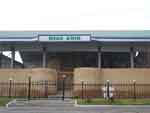In the process of study it became known that the settlement of Mingurik, located on the channel of Salar close to current North railway station became the real town with defensive walls and fortress-citadel.
 The town became the heir of the first urban settlement, discovered in Shash-tepa. In addition to it, on its territory the large cult center of regional importance was formed. According to the research works of Tashkent team of Academy of Science of Uzbekistan in 2008, the heart of it was the building of raw brick and pahsa in the form of square with integrated semicircular towers at each side. The layout inside the square and the scheme of the building develops the principle, based in cult house in Shash-tepa.
The town became the heir of the first urban settlement, discovered in Shash-tepa. In addition to it, on its territory the large cult center of regional importance was formed. According to the research works of Tashkent team of Academy of Science of Uzbekistan in 2008, the heart of it was the building of raw brick and pahsa in the form of square with integrated semicircular towers at each side. The layout inside the square and the scheme of the building develops the principle, based in cult house in Shash-tepa.
Huge piles of clean ash from the western side of the building and supplies of wood fuel in one of the inner premises are the signs of its function as the temple, on the top of which was the outdoor altar of fire.
Not accidentally Kangyuy is mentioned in the Avesta under name “Kangha - high and holy". Recent archaeological excavations have shown that the complex on the territory of Mingurik was erected by population, spiritual culture of which had the fire and sun worship in the base. Probably it survived until the IV century AD. This complex indicates that the territory of modern Tashkent in antiquity was the part of the largest religious center of the state Kangyuy. The beginning of urbanization in Tashkent can be seen in written Chinese sources from the end of the II century BC. The chronicle of the senior house of Han "Shizi" reports about the region and town Yuni in the State of Kangyuy, the heart of which in science is accepted to place in the Tashkent oasis.
Later Chinese sources called the region and town Shi, which was inherited by Yuni. According to the sources Shi turned into small independent state after collapse of the State of Kangyuy into small possessions in the III-IV centuries AD. By facts of archeology, the ancient capital of this possession was located on the huge settlement Kanka in 70 km to the south from Tashkent. At the same time the number of urban settlements existed within the borders of future Tashkent as it mentioned above.
If the urban settlement on the territory of Shash-tepe became the direct source for the development of urban culture in Tashkent district, then the settlement of Ming-Urik, situated in the north from it on the bank of Salar channel, could be considered as the ancient center of the Tashkent city, appeared in the result of intensive developing of water system of Salar-Jun and the development of urbanization.
Since first centuries AD a whole number of human settlements appears along the water system of Salar-Jun. These are settlements, known today as Kugai-tepa, Ming-Urik, Taukat-tepa, Buzgon-tepa and others.

